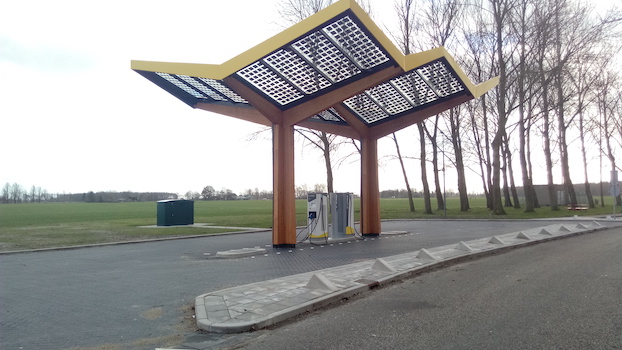Editor's note: The chicken and the egg and the charging station

He has pointed out to Ukrainians the best way to solve their neighbourly spat (“just let the Russians keep all that territory they invaded, it will be fine”), weighed in on China’s aspirations for Taiwan (“Hong Kong went great, try that again”), and now Elon Musk has seen fit to advise Canada’s government on how it should approach the challenge of making electric vehicles attractive to the rest of us. More specifically, Tesla Motors Canada has submitted formal recommendations on EV policy to the federal government’s Standing Committee on Finance, as part of consultations in advance of next year’s budget.
The document is admirably detailed, right down to price-points for tax credits to entice companies to invest in the charging infrastructure that will be necessary to support large numbers of EVs. Author Audrey Dépault, Tesla Canada’s Senior Advisor of Public Policy and Business Development, touts a strategy of placing fast-charging hubs in the country’s highest-priced neighbourhoods, where presumably the most well-heeled early adopters of EVs will want plenty of options to charge their rides.
“The intent would be to allow charging operators to establish themselves in the Hub without a fee, but they would pay for the full capital cost of their equipment, its installation, and electricity submetering,” she explains, adding that these operators would also be on the hook for all the electricity they use, as well as the maintenance and operating costs of the facility.
“Government would make the site available for 10 years,” she concludes. “At the end of the 10-year period, the government would continue to own a significant and well serviced parcel of land that could be maintained as a charging hub or sold when the EV charging market becomes more mature.”
It is crucial to envision what is being proposed here. Tesla’s self-described hub is a paved lot with 30-50 parking stalls. Picture a cross-country network of mini-malls, without the stores, owned by federal government, located on expensive real estate, in numbers significant enough to soothe the range anxiety that afflicts any EV driver.


These are supposed to be the climate-friendly filling stations of the 21st century. They will be a far cry from the familiar stops that grew up during the 20th century and dot the landscape, so frequently that it is hard to find a “last chance for gas” sign anywhere in Canada. Such signs, an earlier generation’s homage to range anxiety, were common in 1940, when Edward Hopper painted his iconic “Gas”. At that point, this infrastructure — and the entire highway system — was still in its infancy. Over decades, the distribution of petroleum products matured to the point where last-chance signs disappeared and drivers no longer felt range anxiety. Urban-dwelling Canadians now take access to gasoline for granted, much as they do access to electricity or treated water.
However, charging hubs are not going to be able to emerge in the same leisurely paced, organic fashion, if EVs re-define the market for personal transportation in coming years. Prospective owners of these cars will have to be pulled into this market with assurances of the same convenience and security they now enjoy with gasoline, which means a parallel re-fueling infrastructure will have to be in place before they start buying. Meanwhile, prospective owners of these charging stations will want their own assurances of a worthwhile investment, even as the size and extent of this new market remains undetermined.
Hence Tesla’s call to government, to resolve this chicken and egg conundrum. As in Ukraine or Taiwan, this is no modest ask. The outlay for a ready-made, national network of charging hubs would come with a serious price tag. This cost could be tucked away in one of the less obvious nooks or crannies of the federal budget, but for the sake of consistency, the government should highlight this initiative in the same loud way they have welcomed battery manufacturers and EV manufacturers into Canada with open arms. Charging stations are considerably less sexy, of course, but the rest of this enterprise will not get very far without them.
Nor do Tesla’s budget recommendations stop with EVs most consumers would own. A second section deals with medium- and heavy-duty vehicles — presumably the large trucks that haul goods from one part of this continent to another, as well as the smaller ones that deliver goods to retailers in your neighbourhood. Here, too, Dépault outlines government incentives to create charging infrastructure dedicated to this cohort of vehicles; this despite the fact that this class of EVs does not yet really exist, apart from prototypes that manufacturers might be playing with. Tesla has occasionally shown off its own futuristic-looking trucks, although little is known about them, or indeed about any EVs established truck-makers might be considering.
What we do know for certain is that any of these vehicles will have to be charged, likely with equipment that delivers much more electricity than the charging stations that would be sufficient for a passenger car.
“Electric trucks provide a good return on investment for businesses, but power upgrades for charging can be a significant one-time capital expense that may discourage some freight carriers,” states the budget recommendation from Tesla Canada. “This can be addressed by establishing a government program to provide grants to freight haulers in support of the capital costs associated with installing upgraded or new electrical services needed to charge electric trucks.”
In other words, the federal government would help all players in the trucking industry upgrade the electrical capacity of their facilities, which would be a necessary incentive to get them to purchase these new vehicles. Here the stakes will be much higher than they will be for people purchasing cars, as a backbone industry is asked to discard its existing fleet of trucks — most of them in good, working, money-making order — and spend large amounts of new money on EVs that would reposition their business model around technology that will be entirely new to these operators.
As if that proposition were not complicated enough, when the future of trucking has come up in previous discussions, Canadians’ thoughts have headed in an entirely different direction. By the time the federal budget is tabled next year, the highway between Calgary and Edmonton should be preparing to host trucks running on hydrogen.
How those vehicles will re-fuel, and where that hydrogen will come from, are matters that might also find their way into the budget deliberations. The federal government has regularly pointed to hydrogen’s bright future, which means now is the time to raise pesky problems such as what those filling stations will look like, and who will own or operate them. There might even be another thoughtful letter to the Standing Committee on Finance, from some representative of hydrogen producers, about how the federal government should build the infrastructure necessary to create a sustainable market for this climate-friendly energy source.
As for the rest of us, we will wait patiently to see what exactly winds up in the budget this coming spring. You can join us for a deep dive into this document — and many other topics around innovation, novel technologies, and research — in April at our 22nd annual conference, happening in person at the National Arts Centre in Ottawa. Until then, rest assured that we will be closely following the promises and policy announcements around hydrogen, electric vehicles, and other rapidly evolving fields that will re-shape our lives as profoundly as gas stations were preparing to do in 1940.
R$
| Organizations: | |
| People: | |
| Topics: |
Events For Leaders in
Science, Tech, Innovation, and Policy
Discuss and learn from those in the know at our virtual and in-person events.
See Upcoming Events
You have 0 free articles remaining.
Don't miss out - start your free trial today.
Start your FREE trial Already a member? Log in
By using this website, you agree to our use of cookies. We use cookies to provide you with a great experience and to help our website run effectively in accordance with our Privacy Policy and Terms of Service.


.png)


